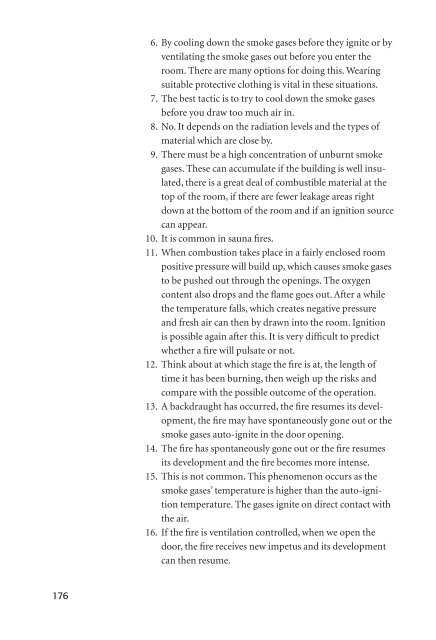Create successful ePaper yourself
Turn your PDF publications into a flip-book with our unique Google optimized e-Paper software.
176<br />
6. By cooling down the smoke gases before they ignite or by<br />
ventilating the smoke gases out before you enter the<br />
room. There are many options for doing this. Wearing<br />
suitable protective clothing is vital in these situations.<br />
7. The best tactic is to try to cool down the smoke gases<br />
before you draw too much air in.<br />
8. No. It depends on the radiation levels and the types of<br />
material which are close by.<br />
9. There must be a high concentration of unburnt smoke<br />
gases. These can accumulate if the building is well insulated,<br />
there is a great deal of combustible material at the<br />
top of the room, if there are fewer leakage areas right<br />
down at the bottom of the room and if an ignition source<br />
can appear.<br />
10. It is common in sauna fi res.<br />
11. When combustion takes place in a fairly enclosed room<br />
positive pressure will build up, which causes smoke gases<br />
to be pushed out through the openings. The oxygen<br />
content also drops and the fl ame goes out. After a while<br />
the temperature falls, which creates negative pressure<br />
and fresh air can then by drawn into the room. Ignition<br />
is possible again after this. It is very diffi cult to predict<br />
whether a fi re will pulsate or not.<br />
12. Think about at which stage the fi re is at, the length of<br />
time it has been burning, then weigh up the risks and<br />
compare with the possible outcome of the operation.<br />
13. A backdraught has occurred, the fi re resumes its development,<br />
the fi re may have spontaneously gone out or the<br />
smoke gases auto-ignite in the door opening.<br />
14. The fi re has spontaneously gone out or the fi re resumes<br />
its development and the fi re becomes more intense.<br />
15. This is not common. This phenomenon occurs as the<br />
smoke gases’ temperature is higher than the auto-ignition<br />
temperature. The gases ignite on direct contact with<br />
the air.<br />
16. If the fi re is ventilation controlled, when we open the<br />
door, the fi re receives new impetus and its development<br />
can then resume.

















